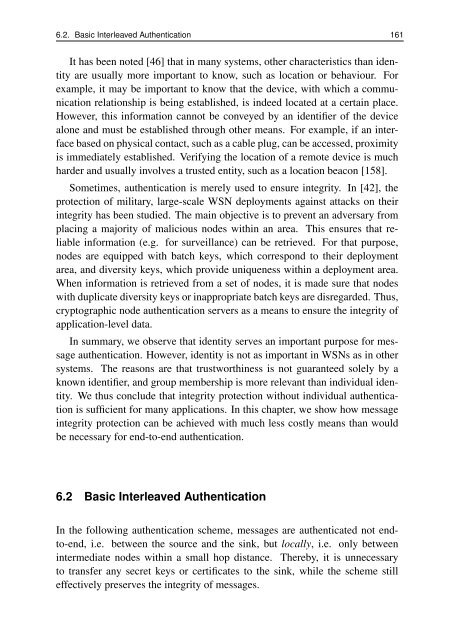Protocols for Secure Communication in Wireless Sensor Networks
Protocols for Secure Communication in Wireless Sensor Networks
Protocols for Secure Communication in Wireless Sensor Networks
You also want an ePaper? Increase the reach of your titles
YUMPU automatically turns print PDFs into web optimized ePapers that Google loves.
6.2. Basic Interleaved Authentication 161<br />
It has been noted [46] that <strong>in</strong> many systems, other characteristics than identity<br />
are usually more important to know, such as location or behaviour. For<br />
example, it may be important to know that the device, with which a communication<br />
relationship is be<strong>in</strong>g established, is <strong>in</strong>deed located at a certa<strong>in</strong> place.<br />
However, this <strong>in</strong><strong>for</strong>mation cannot be conveyed by an identifier of the device<br />
alone and must be established through other means. For example, if an <strong>in</strong>terface<br />
based on physical contact, such as a cable plug, can be accessed, proximity<br />
is immediately established. Verify<strong>in</strong>g the location of a remote device is much<br />
harder and usually <strong>in</strong>volves a trusted entity, such as a location beacon [158].<br />
Sometimes, authentication is merely used to ensure <strong>in</strong>tegrity. In [42], the<br />
protection of military, large-scale WSN deployments aga<strong>in</strong>st attacks on their<br />
<strong>in</strong>tegrity has been studied. The ma<strong>in</strong> objective is to prevent an adversary from<br />
plac<strong>in</strong>g a majority of malicious nodes with<strong>in</strong> an area. This ensures that reliable<br />
<strong>in</strong><strong>for</strong>mation (e.g. <strong>for</strong> surveillance) can be retrieved. For that purpose,<br />
nodes are equipped with batch keys, which correspond to their deployment<br />
area, and diversity keys, which provide uniqueness with<strong>in</strong> a deployment area.<br />
When <strong>in</strong><strong>for</strong>mation is retrieved from a set of nodes, it is made sure that nodes<br />
with duplicate diversity keys or <strong>in</strong>appropriate batch keys are disregarded. Thus,<br />
cryptographic node authentication servers as a means to ensure the <strong>in</strong>tegrity of<br />
application-level data.<br />
In summary, we observe that identity serves an important purpose <strong>for</strong> message<br />
authentication. However, identity is not as important <strong>in</strong> WSNs as <strong>in</strong> other<br />
systems. The reasons are that trustworth<strong>in</strong>ess is not guaranteed solely by a<br />
known identifier, and group membership is more relevant than <strong>in</strong>dividual identity.<br />
We thus conclude that <strong>in</strong>tegrity protection without <strong>in</strong>dividual authentication<br />
is sufficient <strong>for</strong> many applications. In this chapter, we show how message<br />
<strong>in</strong>tegrity protection can be achieved with much less costly means than would<br />
be necessary <strong>for</strong> end-to-end authentication.<br />
6.2 Basic Interleaved Authentication<br />
In the follow<strong>in</strong>g authentication scheme, messages are authenticated not endto-end,<br />
i.e. between the source and the s<strong>in</strong>k, but locally, i.e. only between<br />
<strong>in</strong>termediate nodes with<strong>in</strong> a small hop distance. Thereby, it is unnecessary<br />
to transfer any secret keys or certificates to the s<strong>in</strong>k, while the scheme still<br />
effectively preserves the <strong>in</strong>tegrity of messages.
















